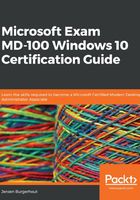
Summary
In this chapter, you learned what IPv4 and IPv6 addresses are and how they work to communicate between two or more hosts. Another essential part of an IP address is the subnets, which indicate whether the computer is on the same network or another network. You also learned what public, private, and APIPA IP addresses are.
We talked about how you can connect your Windows 10 device to a cellular network and how you can share this internet connectivity with the built-in hotspot feature. Furthermore, you learned about the VPN possibilities in Windows 10 and how a VPN communicates with different protocols that you can use. You also learned how you can create a VPN connection and other VPN options, such as implementing Always On VPN so that users are always automatically connected to company resources on your corporate network.
Aside from the previously mentioned connectivities, you learned about the Wi-Fi 802.11x norms and you are now able to secure your wireless network. Furthermore, you now know how you can connect to a Wi-Fi network. Also, after reading this chapter, you are aware of the possible network issues you may encounter, how to troubleshoot those issues, and which tools you can use for this.
In the next chapter, you will learn about remote management via PowerShell to a Windows 10 device. By reading this chapter, you will understand how you can connect to a Windows 10 device with the use of the Remote Desktop Protocol.